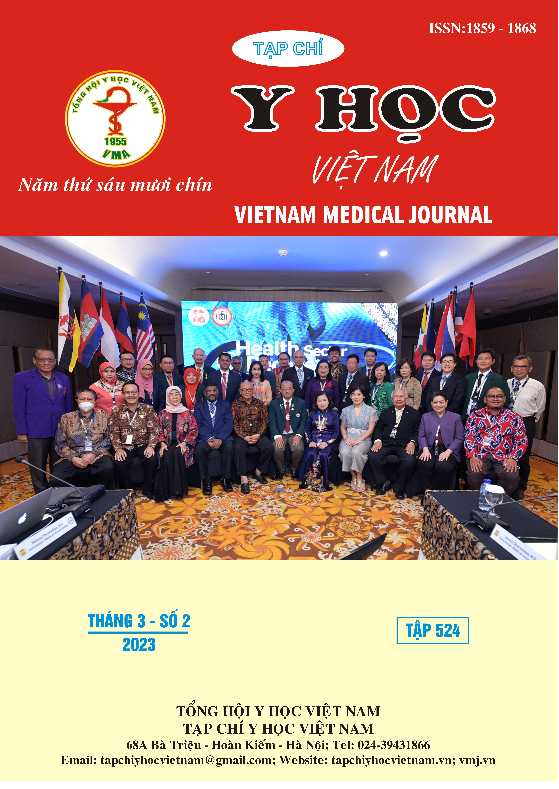THE SURGICAL SITE INFECTION INCIDENCE AND RISK FACTORS AT UNIVERSITY MEDICAL CENTER, HO CHI MINH CITY
Main Article Content
Abstract
Background: Surgical Site Infection (SSI) is one of the most common healthcare-associated infections, increasing healthcare cost, hospital stay, morbidity burden as well as the rate of mortality. Objectives: The aim of this study was to decribe the incidence of SSI and risk factors at University Medical Center, Ho Chi Minh City. Methods: A prospective cross-sectional study was conducted involving 859 operated patients at University Medical Center, Ho Chi Minh City during 05/2020 - 12/2020. Background information including having diabetes, ASA score, antibiotic prophylaxis, the type of the surgical procedure, preoperation bathing, operative duration and surgical site infection were collected. Results: The overall SSI rate was 2,2%, ranging from 1,3% to 20,0%. Among which, the SSI rates classified by procedure type were: 20% in small bowel surgery, 5,5% in cardiac surgery, 4,5% in gastrectomy, 4,2% in cholecystectomy and hepatobiliopancreatic surgery, 4,1% in craniotomy. The mean time of the duration between surgery starting-point and the onset of infection was 11,9 ± 7,8 days, while the longest duration was in cardiovascular surgery with over 20 days. The rate of SSI in patients with diabetes was related with a 6,5-fold increase (95% CI: 2,8-14,7); ASA score ≥ 3 with 2,6-fold increase (95% CI: 1,8-3,6); operative time prolonging more than 1 hour with 1,3-fold increase (95% CI: 1,1-1,6); and every one more surgeon added to the operating team lead to a 1,9-fold increased in SSI rates (95% CI: 1,3-2,9). Conclusions: The overall incidence of SSI in our study was 2,2%. The mean time from surgery starting-point until the onset of infection is 11,9 ± 7,8 days. The significant risk factors were having diabetes, high ASA score, increased operative duration, increased length of hospital stay, the type of intervention and the increased number of surgeons.
Article Details
Keywords
Surgical site infection, surgical-related infection
References
2. Zimlichman, E., et al., Health Care–Associated Infections: A Meta-analysis of Costs and Financial Impact on the US Health Care System. JAMA Internal Medicine, 2013. 173(22): p. 2039-2046
3. World Health O. (2018), "Global guidelines for the prevention of surgical site infection", World Health Organization Geneva.
4. Viet Nam Ministry of Health, Guidelines for the prevention of surgical site infection issued under the Decision No.3671/QD-BYT dated September 27, 2012. 2012, Viet Nam Ministry of Health: Ha Noi.
5. Viet Hung, N., et al., Surgical Site Infection Rates in Seven Cities in Vietnam: Findings of the International Nosocomial Infection Control Consortium. Surg Infect (Larchmt), 2016. 17(2): p. 243-9.
6. Fields, A.C., J.C. Pradarelli, and K.M.F. Itani, Preventing Surgical Site Infections: Looking Beyond the Current Guidelines. JAMA, 2020. 323(11): p. 1087-1088
7. Harbarth S, Huttner B, Gervaz P, Fankhauser C, Chraiti MN et al. (2008) Risk factors for methicillin-resistant Staphylococcus aureus surgical site infection. Infect Control Hosp Epidemiol 29: 890-893
8. Mawalla B, Mshana SE, Chalya PL, Imirzalioglu C, Mahalu W (2011) Predictors of surgical site infections among patients undergoing major surgery at Bugando Medical Centre in Northwestern Tanzania. BMC Surg
9. Nguyễn Đình Xướng và cộng sự (2017), “Khảo sát tỷ lệ nhiễm khuẩn vết mổ và các yếu tố liên quan tại khoa ngoại thần kinh Bệnh viện Nguyễn Tri Phương 2014-2016”, Tạp chí Y học Thành phố Hồ Chí Minh.


